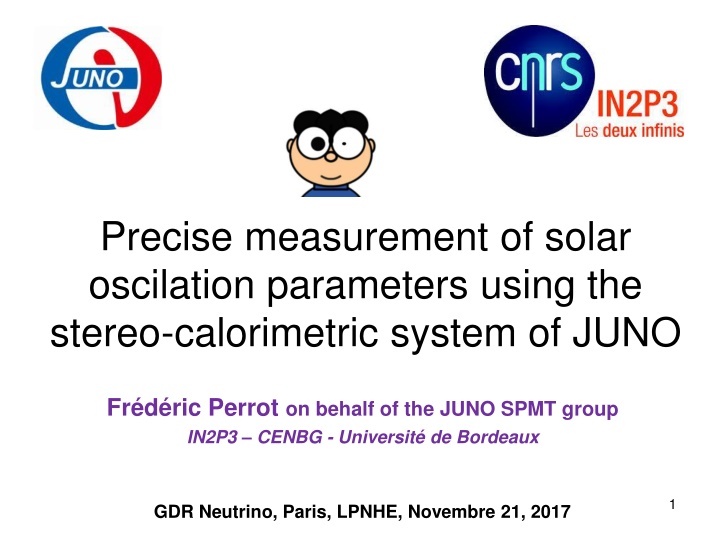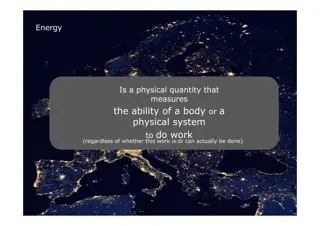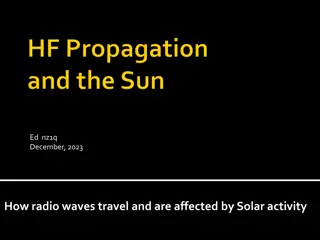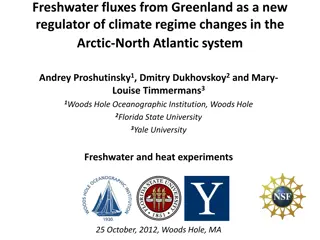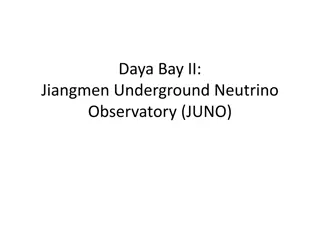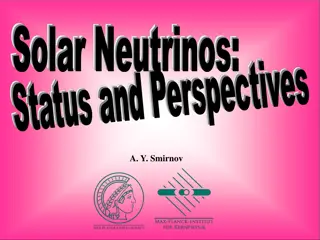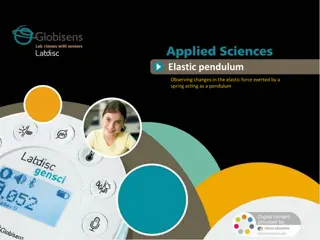Precise Measurement of Solar Oscillation Parameters Using Stereo-Calorimetric System of JUNO
The JUNO experiment aims to achieve a 3% energy resolution at 1 MeV by utilizing a stereo-calorimetric system with large and small PMT systems. The motivation for stereo calorimetry in JUNO is to improve energy resolution beyond current LS-based neutrino experiments and control non-stochastic term uncertainties. The system comprises LPMT and SPMT systems to enhance precise measurement of solar oscillation parameters. By combining two independent instruments, JUNO can address challenges in energy resolution and calibration, offering advancements in neutrino research.
Download Presentation

Please find below an Image/Link to download the presentation.
The content on the website is provided AS IS for your information and personal use only. It may not be sold, licensed, or shared on other websites without obtaining consent from the author.If you encounter any issues during the download, it is possible that the publisher has removed the file from their server.
You are allowed to download the files provided on this website for personal or commercial use, subject to the condition that they are used lawfully. All files are the property of their respective owners.
The content on the website is provided AS IS for your information and personal use only. It may not be sold, licensed, or shared on other websites without obtaining consent from the author.
E N D
Presentation Transcript
Precise measurement of solar oscilation parameters using the stereo-calorimetric system of JUNO Fr d ric Perrot on behalf of the JUNO SPMT group IN2P3 CENBG - Universit de Bordeaux 1 GDR Neutrino, Paris, LPNHE, Novembre 21, 2017
Schematic view of the JUNO detector Top Tracker Water Pool (D=43 m) Central Detector 20,000 tons of LS in an acrylic sphere (D=35.4 m) Steel Truss holding PMTs 17500 x 20 PMTs (LPMT) 25000 x 3 PMTs (SPMT) Why using two systems of PMTs ? 2
Large and Small PMT systems We can look at the same events with two independent and complementary instruments! LPMT system: 17,000x20 PMTs SPMT system: 25,000x3 PMTs HZC-Photonics XP72B22 PMT NNVT MCP-PMT (12,000 units) Photon coverage: 75% Nb of photoelectron @1 MeV ~ 1200 Hamamatsu R12860 PMT (5,000 units) Photon coverage: 2% Nb of photoelectron @1 MeV ~ 35 Aid to calorimetry (stereo) + standalone physics Main calorimetric system 3
Motivation for stereo calorimetry in JUNO Energy resolution of current LS-based neutrino experiments Example : Double Chooz Detector Target Mass (tons) 1000 30 16 20 300 20 000 Energy resolution 6% / E Experiment KamLAND Double Chooz Daya Bay RENO Borexino JUNO 8% / E Energy resolution is dominated by the number of photoelectrons detected 5% / E 3% / E Next generation detector (JUNO): energy resolution will be improved by more than a factor 2 No more dominated by photostatistics (stochastic term ST) but by systematic uncertainties (non-stochastic term NST) 4
Motivation for stereo calorimetry in JUNO Goal : to reach a 3% energy resolution @ 1 MeV 2 ?(?) ? ????? ? Stochastic term: depends on photostatistics (~1200 PE) Non-stochastic term: residual issues after calibration 2 = + ???? ???? Typical LS experiments: NST ~ 2% JUNO Challenge for JUNO : to control the non-stochastic term at an unprecedented level never achieved (< 1%) 5
Two calorimetry observables in LS exp. PhotoMultiplier Tube Photons PhotoElectrons (PE) Energy deposition Liquid Scintillator MeV Photons Mean PMT illumination = < N(PE) > / PMT Photon Counting Charge Integration PMT PMT > 0.5 < 0.5 PE =charge PE = hit gain Different systematics PMT gain linearity Gain = f(PE) ? Single photoelectron threshold REDUNDANCY 6
Two calorimetry observables in JUNO Dynamic range @ 1 MeV Only charge integration Both observables JUNO LPMT system has the highest dynamic range: from 0.07 PE/PMT (center) to 10 PE/PMT (edge) @1 MeV charge extraction not trivial with gain depending on number of PE JUNO SPMT system is always in Photon Counting mode 7
Stereo calorimetry: energy reconstruction ? ??????????? E = ? PE Several parameters are affecting the energy reconstruction Uniformity: position dependent Stability: time dependent Linearity: energy dependent For a limited dynamic range, f terms are evaluated independently E[MeV] = ???? ??? ??? ???? PE For a wide dynamic range, correlation among f terms is no more negligible (degeneracy) E[MeV] = ????,?,?,??,?,?? PE Difficult to disentangle all the effects with calibration sources 8
Co-60 calibration (simulation) True and Reconstructed energy at a given energy (here 2.6 MeV) SPMT LPMT 1% deviation Much better agreement (negligible charge non- linearity for 3 PMTs) A charge non-linearity at a given energy for LPMT can be taken as a spatial non-uniformity can be corrected by SPMT system 9
Physics case with the SPMT system
SPMT system as an aider to LPMT system 1. High precision calorimetry (stereo or double calorimetry) Improve response systematics within IBD physics Aide to achieve <3% resolution @ 1 MeV 2. Physics: standalone measurement of solar oscillation parameters Ensure accurate physics results and validate energy scale 3. Improve inner-detector -reconstruction resolution Aide 9Li/8He tagging/vetoing 4. High rate Supernova pile-up (if very near) Minimise bias in absolute rate & energy spectrum 5. Complementary readout info : time resolution, dynamic range 11
Solar oscillation parameters with JUNO JUNO: unique experiment able to measure precisely 4 oscillation parameters: 13, 12, m212 and | m312| from reactor neutrinos with the LPMT system Oscillation parameter | m312| m212 sin2 ( 12) sin2 ( 13) Current precision 1.7% 2.3% 5.8 % 3.3% JUNO precision ~0.5% ~0.6% ~0.7% ~15% fast slow Solar oscillation parameters ( m212,sin2 12) measured with a precision below 1% Crucial constrains for the future unitarity test of the PMNS matrix in the 3-flavor neutrino model 12
Solar oscillation parameters with JUNO Solving the tension between Kamland results and solar models for the m212 parameter KamLAND At this level of accuracy (<1%), it is crucial to control the systematic uncertainties Is the SPMT system able to perform a standalone measurement in order to cross-check the LPMT results ?
Solar parameters study with SPMT Simulated spectrum of collected PE s Simulated ideal IBD spectrum (true) Etrue (MeV) NPE NPE Detector response matrix for 25,000 x 3 PMTs (correction for the spatial non-uniformity) 35 PE/MeV @ center (18% resolution) Etrue (MeV)
Approach: 2 method NPE spectra from fake MC experiments (100k events) were calculated over the (sin2 12, m212)-space and compared with the nominal one (10M events) sin2 12 2 was used to estimate how a spectrum with varied parameters defers from the nominal one m212 MC Nominal Simultaneous variation of two or more parameters can mimic the nominal spectrum
SPMT sensitivity study Statistics : 2000 days, 100% efficiency Reactor spectrum 3% rate 2% shape uncertainty Reactor spectrum How the uncertainties and backgrounds affect the precision on solar parameters?
SPMT sensitivity study Impact of separate & combined uncertainties on the solar parameter sensitivity SPMT, all uncertainties 1 1 2 3 2 3 Impact of correlated flux uncertainty limited thanks to complementarity of rate+shape information. Backgrounds (mainly geo- and accidentals) play an important role The promising results of this preliminary study has been cross-checked with an independant approach using continuous distributions (Hiroshi Nunokawa) Good agreement between the two independent approaches with SPMT
SPMT sensitivity study: first conclusions Sensitivity of the SPMT system to sin2 12 and m212 is estimated with the 2 method The SPMT system standalone is able to improve the sensitivity on these parameters by a factor 3-4 compared to the current best estimations Expected sensitivities with SPMT: sin2 12 ~ 1% m212 ~ 0.5% Very competitive sensitivities compared to JUNO LPMT system with different systematics (redundancy!)
SPMT system as an aider to LPMT system 1. High precision calorimetry (stereo or double calorimetry) Improve response systematics within IBD physics Aide to achieve <3% resolution @ 1 MeV 2. Physics: standalone measurement of solar oscillation parameters Ensure accurate physics results and validate energy scale 3. Improve inner-detector -reconstruction resolution Aide 9Li/8He tagging/vetoing 4. High rate Supernova pile-up (if very near) Minimise bias in absolute rate & energy spectrum 5. Complementary readout info : time resolution, dynamic range 19
SPMT system sketch MAIN DAQ SURFACE Under Water Box 128 ch. Photomultipliers High Voltage Decoupling HV/Signal Front-End Readout DAQ 2 Low Voltage Clock Data 100m 20m 25,000 PMTs ~200 UWB 21
SPMT system schematics SPMT Hardware : consortium between China, Chile and France International technical coordination by IN2P3 in France
3 PMTs SPMT is a very new system in JUNO ! 2014-2015: starting point of the idea and physics studies Feb 2017: accepted by the JUNO Collaboration May 2017: successful bidding with HZC company (China) Jan 2018- Dec 2019: production of 25,000 x 3 PMTs !! on time with the overall schedule for JUNO (2020) Parameter QE x CE TTS ( ) HV @ 3.106 SPE resolution Dark rate @1/3 PE Requirement 24% <2.1 ns <1300 V 35% <1.8 kHz HZC-Photonics XP72B22 PMT bulb shape optimized to improve TTS First 5 tubes are under investigation
UWB studies Cables and underwater connectors: current investigation with companies Water pressure test tank UWBstudies 2017-2018: prototyping and tests in France (CENBG, CPPM) 2018-2019: production of the 200 UWB in Chile
Front-End Board Main deliver of IN2P3 for SPMT (APC, CENBG, OMEGA, Subatech) Produced and delivered by OMEGA 8 CATiROC ASICS per board: 16 input channels Pre-amplifier for each channel Programmable trigger threshold Output handled by a FPGA
Front-End Board Block diagram and routing done in spring 2017 4 bare PCB produced in june 2017
Front-End Board 1st PCB populated in July 2017 ! End of 2017: 3 boards to be fully tested and characterized in France (APC, CENBG, Subatech) First part of 2018: new updated version of the boards + tests Fall 2018 Mid-2019: production of the 200 boards
3 PMTs production and testing JUNO site Installation+ commissionning Dongguang University Acceptance+ sub-sample deep testing HZC company PMT prod+mass testing
SPMT schedule 25 000 PMTs delivered by the end of 2019 SPMT system delivered by the end of 2019 A lot to do but schedule under control
Summary and Conclusions JUNO will use 2 systems LPMT+SPMT in order to achieve a high precision calorimetry for mass hierarchy determination with 3% energy resolution @1MeV (systematics <1%) Physics with SPMT: standalone measurement of solar oscillation parameters very promising among other physics (Supernova) SPMT hardware: production and testing of 25000x3 PMTs in 2 years (2018- 2019) by HZC company Production of 200 Front-End boards and UWB main deliver of IN2P3 involving 5 IN2P3 laboratories CDR paper on SPMT system will be available soon
